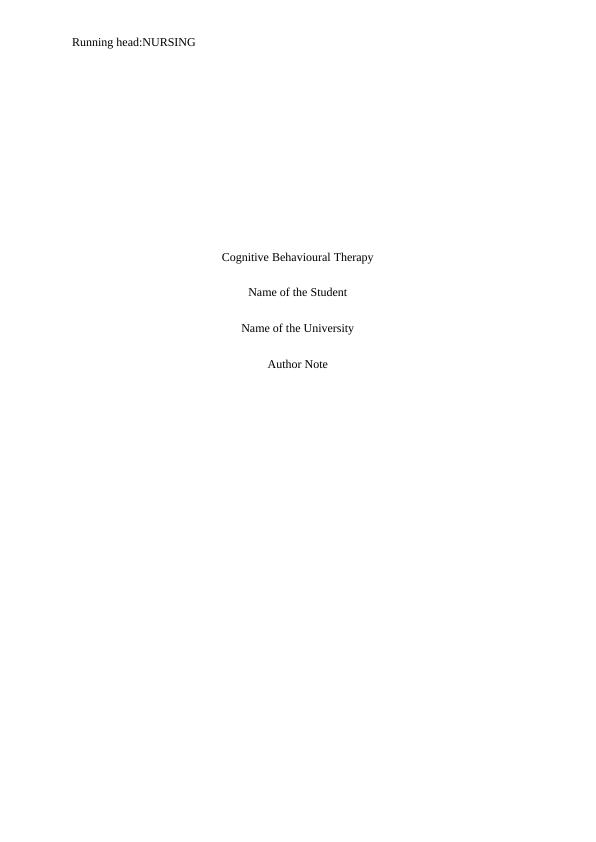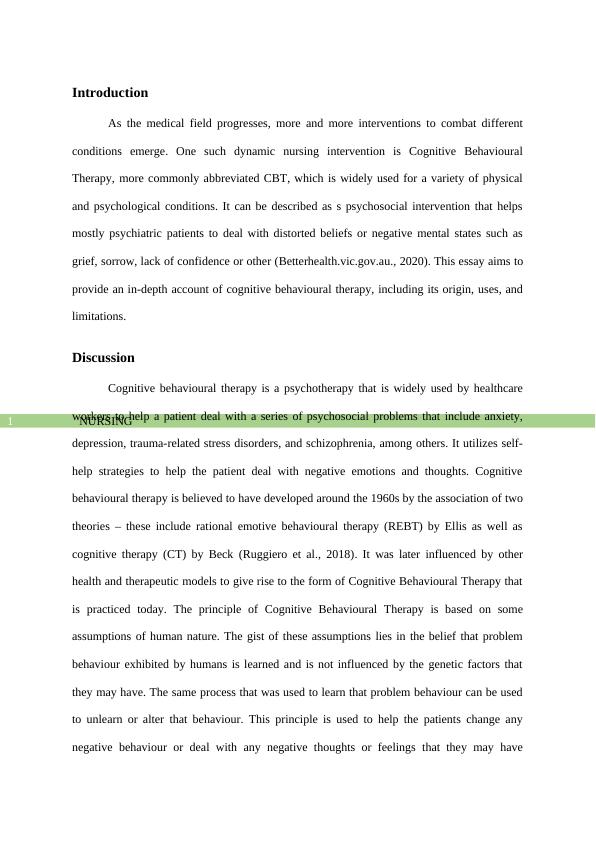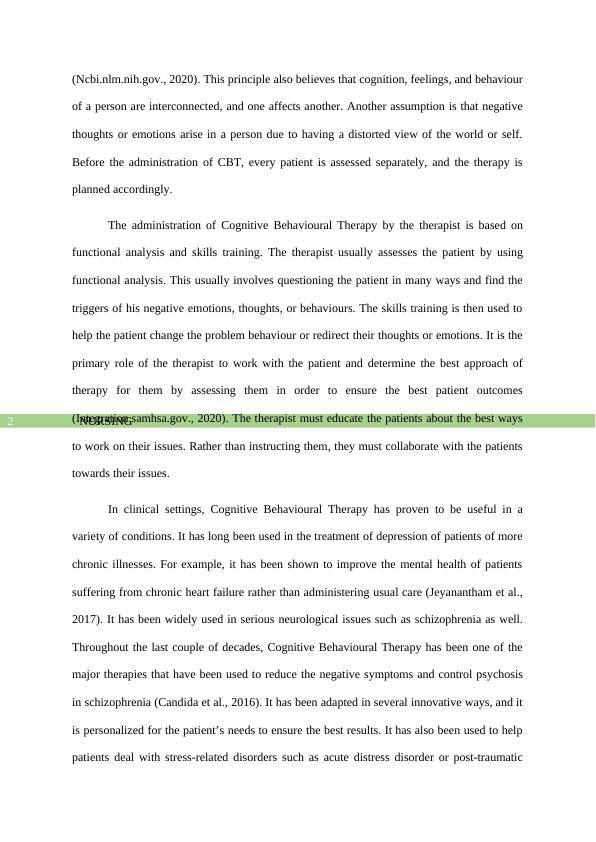Cognitive Behavioral Therapy | Report
Added on 2022-09-07
7 Pages1661 Words47 Views
Running head:NURSING
Cognitive Behavioural Therapy
Name of the Student
Name of the University
Author Note
Cognitive Behavioural Therapy
Name of the Student
Name of the University
Author Note

NURSING1
Introduction
As the medical field progresses, more and more interventions to combat different
conditions emerge. One such dynamic nursing intervention is Cognitive Behavioural
Therapy, more commonly abbreviated CBT, which is widely used for a variety of physical
and psychological conditions. It can be described as s psychosocial intervention that helps
mostly psychiatric patients to deal with distorted beliefs or negative mental states such as
grief, sorrow, lack of confidence or other (Betterhealth.vic.gov.au., 2020). This essay aims to
provide an in-depth account of cognitive behavioural therapy, including its origin, uses, and
limitations.
Discussion
Cognitive behavioural therapy is a psychotherapy that is widely used by healthcare
workers to help a patient deal with a series of psychosocial problems that include anxiety,
depression, trauma-related stress disorders, and schizophrenia, among others. It utilizes self-
help strategies to help the patient deal with negative emotions and thoughts. Cognitive
behavioural therapy is believed to have developed around the 1960s by the association of two
theories – these include rational emotive behavioural therapy (REBT) by Ellis as well as
cognitive therapy (CT) by Beck (Ruggiero et al., 2018). It was later influenced by other
health and therapeutic models to give rise to the form of Cognitive Behavioural Therapy that
is practiced today. The principle of Cognitive Behavioural Therapy is based on some
assumptions of human nature. The gist of these assumptions lies in the belief that problem
behaviour exhibited by humans is learned and is not influenced by the genetic factors that
they may have. The same process that was used to learn that problem behaviour can be used
to unlearn or alter that behaviour. This principle is used to help the patients change any
negative behaviour or deal with any negative thoughts or feelings that they may have
Introduction
As the medical field progresses, more and more interventions to combat different
conditions emerge. One such dynamic nursing intervention is Cognitive Behavioural
Therapy, more commonly abbreviated CBT, which is widely used for a variety of physical
and psychological conditions. It can be described as s psychosocial intervention that helps
mostly psychiatric patients to deal with distorted beliefs or negative mental states such as
grief, sorrow, lack of confidence or other (Betterhealth.vic.gov.au., 2020). This essay aims to
provide an in-depth account of cognitive behavioural therapy, including its origin, uses, and
limitations.
Discussion
Cognitive behavioural therapy is a psychotherapy that is widely used by healthcare
workers to help a patient deal with a series of psychosocial problems that include anxiety,
depression, trauma-related stress disorders, and schizophrenia, among others. It utilizes self-
help strategies to help the patient deal with negative emotions and thoughts. Cognitive
behavioural therapy is believed to have developed around the 1960s by the association of two
theories – these include rational emotive behavioural therapy (REBT) by Ellis as well as
cognitive therapy (CT) by Beck (Ruggiero et al., 2018). It was later influenced by other
health and therapeutic models to give rise to the form of Cognitive Behavioural Therapy that
is practiced today. The principle of Cognitive Behavioural Therapy is based on some
assumptions of human nature. The gist of these assumptions lies in the belief that problem
behaviour exhibited by humans is learned and is not influenced by the genetic factors that
they may have. The same process that was used to learn that problem behaviour can be used
to unlearn or alter that behaviour. This principle is used to help the patients change any
negative behaviour or deal with any negative thoughts or feelings that they may have

NURSING2
(Ncbi.nlm.nih.gov., 2020). This principle also believes that cognition, feelings, and behaviour
of a person are interconnected, and one affects another. Another assumption is that negative
thoughts or emotions arise in a person due to having a distorted view of the world or self.
Before the administration of CBT, every patient is assessed separately, and the therapy is
planned accordingly.
The administration of Cognitive Behavioural Therapy by the therapist is based on
functional analysis and skills training. The therapist usually assesses the patient by using
functional analysis. This usually involves questioning the patient in many ways and find the
triggers of his negative emotions, thoughts, or behaviours. The skills training is then used to
help the patient change the problem behaviour or redirect their thoughts or emotions. It is the
primary role of the therapist to work with the patient and determine the best approach of
therapy for them by assessing them in order to ensure the best patient outcomes
(Integration.samhsa.gov., 2020). The therapist must educate the patients about the best ways
to work on their issues. Rather than instructing them, they must collaborate with the patients
towards their issues.
In clinical settings, Cognitive Behavioural Therapy has proven to be useful in a
variety of conditions. It has long been used in the treatment of depression of patients of more
chronic illnesses. For example, it has been shown to improve the mental health of patients
suffering from chronic heart failure rather than administering usual care (Jeyanantham et al.,
2017). It has been widely used in serious neurological issues such as schizophrenia as well.
Throughout the last couple of decades, Cognitive Behavioural Therapy has been one of the
major therapies that have been used to reduce the negative symptoms and control psychosis
in schizophrenia (Candida et al., 2016). It has been adapted in several innovative ways, and it
is personalized for the patient’s needs to ensure the best results. It has also been used to help
patients deal with stress-related disorders such as acute distress disorder or post-traumatic
(Ncbi.nlm.nih.gov., 2020). This principle also believes that cognition, feelings, and behaviour
of a person are interconnected, and one affects another. Another assumption is that negative
thoughts or emotions arise in a person due to having a distorted view of the world or self.
Before the administration of CBT, every patient is assessed separately, and the therapy is
planned accordingly.
The administration of Cognitive Behavioural Therapy by the therapist is based on
functional analysis and skills training. The therapist usually assesses the patient by using
functional analysis. This usually involves questioning the patient in many ways and find the
triggers of his negative emotions, thoughts, or behaviours. The skills training is then used to
help the patient change the problem behaviour or redirect their thoughts or emotions. It is the
primary role of the therapist to work with the patient and determine the best approach of
therapy for them by assessing them in order to ensure the best patient outcomes
(Integration.samhsa.gov., 2020). The therapist must educate the patients about the best ways
to work on their issues. Rather than instructing them, they must collaborate with the patients
towards their issues.
In clinical settings, Cognitive Behavioural Therapy has proven to be useful in a
variety of conditions. It has long been used in the treatment of depression of patients of more
chronic illnesses. For example, it has been shown to improve the mental health of patients
suffering from chronic heart failure rather than administering usual care (Jeyanantham et al.,
2017). It has been widely used in serious neurological issues such as schizophrenia as well.
Throughout the last couple of decades, Cognitive Behavioural Therapy has been one of the
major therapies that have been used to reduce the negative symptoms and control psychosis
in schizophrenia (Candida et al., 2016). It has been adapted in several innovative ways, and it
is personalized for the patient’s needs to ensure the best results. It has also been used to help
patients deal with stress-related disorders such as acute distress disorder or post-traumatic

End of preview
Want to access all the pages? Upload your documents or become a member.
Related Documents
The Cognitive-behavioral therapylg...
|7
|1731
|17
Cognitive Behavioural Therapy Assignment Reportlg...
|11
|3018
|20
Cognitive Therapy | Reportlg...
|5
|1042
|17
Case Study on Women Dina Who is Suffering from Obsessive Compulsive Disorderlg...
|5
|1045
|440
Theories of Counseling: Cognitive Behavioral Therapy and Gestalt Therapylg...
|10
|3133
|485
Assignment Cognitive Behavior Therapylg...
|3
|1420
|68